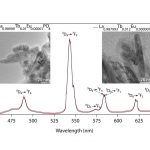Rhabdophane-type single-crystal La1-xEuxPO4∙nH2O (x=0‒0.10) nanorods with high-quality (that is, well-shaped and linear/planar defect free) were prepared by a simple and fast microwave-assisted hydrothermal route, being the optimum autogeneous pressure of 2.3±0.1 bar during their synthesis. Higher values of pressure lead to the loss of the nanorod shape. Eu3+ doping does not affect the thermal stability of the nanorods, indicating that Eu3+ cations, consistently with their smaller size can occupy substitutional positions in the lattice, are not involved in the rate-limiting mechanism of ion diffusion/mobility in the La1-xEuxPO4∙nH2O lattice. Monazite-type single-crystal La1-xEuxPO4 nanorods were obtained by calcining their rhabdophane-type La1-xEuxPO4∙nH2O counterparts at 700 ºC in air.
In addiditon, rhabdophane-type Eu3+,Tb3+-codoped LaPO4‚àônH2O single-crystal nanorods with the compositions La0.99999-xEuxTb0.00001PO4‚àônH2O (x=0‚Äí0.03), La0.99999-yTbyEu0.00001PO4‚àôn‘H2O (y=0‚Äí0.010), and La0.99999-zTbzEu0.000007PO4‚àôn¬ªH2O (z=0‚Äí0.012) were hydrothermally synthesized with microwaves. The Eu3+,Tb3+ codoping did not affect the thermal stability of these nanorods, which is due to the formation of substitutional solid solutions with both Eu3+ and Tb3+ replacing La3+ in the crystal lattice. Monazite-type Eu3+,Tb3+-codoped LaPO4 single-crystal nanorods can be obtained by calcining their rhabdophane-type Eu3+,Tb3+-codoped LaPO4‚àô(n,n‘,n¬ª)H2O counterparts at moderate temperature in air, and that they are thermally stable. It is also observed that, for the same Eu3+,Tb3+-codoping content, the monazite-type Eu3+,Tb3+-codoped LaPO4 nanorods exhibit higher photoluminescent efficiency than the rhabdophane-type Eu3+,Tb3+-codoped LaPO4‚àônH2O nanorods, as it was expected. Moreover, it was found that the highest photoluminescence emission corresponds to the monazite-type La0.96999Eu0.02Tb0.00001PO4 nanorods for the La0.99999-xEuxTb0.00001PO4 system. However, for those compositions energy transfer from Tb3+ to Eu3+ did not occur. In addition, for an efficient energy transfer to occur, a content of at least 1 mol.% Tb3+ is needed in all the studied materials





